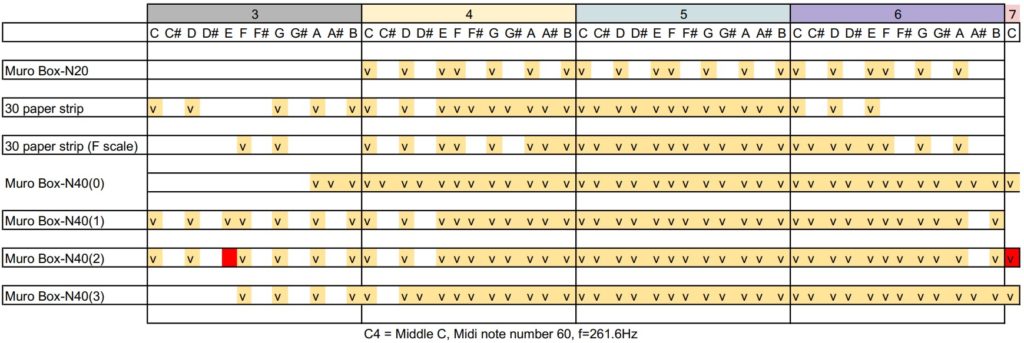Muro Box N40 Update #8-
N40’s Note Selection and Sound Effect Design
Hello Everyone,
In this update, we want to discuss the following items with you:
- the music range and what notes to be included, and how we made this decision
- the introduction “sublime harmony”and survey how many subscribers love it and can pay more for having this unique sound effect
- survey how many subscribers would like to purchase the guitar-shaped resonance box as the add-on option for Muro Box-N40
This update includes the last survey before our Muro Box-N40 pre-launch campaign page is published. In our next update, we will directly display the details of our actual product design, so please seize the last chance to tell how you think about our current design.
The Survey Result of Music Range:
Do you agree that we adjust the new N40 scale to become discontinuous F3~C7 (as shown in the line of Muro Box-N40 (3) in the following figure?
We selected this music range mainly because we want to support the existing 30-note music box melodies from Music Box Maniacs so that our customers can download the free melodies to play on the Muro Box-N40.

According to the survey results recorded on 2023/07/20:
Among 76 English responses, 57 people (about 75%) agree with our music range selection, 10 people (about 13.1%) disagree, and 9 people (about 11.8%) have another idea.
Among 28 Chinese responses, 21 people (about 75%) agree with our music range selection, 4 people (about 14.2%) disagree, and 3 people (about 10.7%) have another idea.
Why We Choose This Music Range Method: Muro Box-N40 (3)
We made the following illustration with a keyboard to help you understand what notes are included in this music range: Muro Box-N40 (3)

The characteristics of this music range is that every note within D4 to C7 are included, and only some semitones are skipped in the lower music range: F3-C4.
Having a large scale of semitones in Muro Box-N40 will help you present the original song more easily in addition to giving you more freedom in creating your own music. For both melody and chord arrangement, extending the music range gives you more notes to use in your music creation.
However, there are still some limits in Muro Box-N40: we choose C Major and A minor to set up the best music range for composing your own music. These two keys containing fewer flats and sharps are more friendly for music beginners.
Of course, you can still create melodies in other majors/minors, and the missing notes in the lower range can still be replaced by the higher range one.
The Selection of Notes in Lower Music Range:
1. Compatible with existing 30-note music box melodies
The reason that we did not choose “Muro Box-N40 (0)”, which does not skip any note betweenA3-C7, is because we wish to allow the Muro Box-N40 to play the existing 30-note music box melodies in Music Box Maniacs. Hence, we extend its music range to F3 to align with the lowest note in 30-note music box melodies.
Note: Some of the paper strips of 30-note music boxes show the lowest note is C3, but this notation is wrong and the actual lowest note is F3. The correct music range for the 30 paper strip music boxes is on F scale. This correction information is found from: https://musicboxmaniacs.com/news/music_box_guide)

2. Widen the Music Range to Open More Options for Chord Arrangement
There are some music arrangement skills that can be applied to create the music box melodies. One of them is to change the music range: from high to low or low to high, so when there are almost 4 octaves, there will be many options for using this technique.
We chose the melody “My Grandfather’s Clock”, a warm and well-known song to give you an example of how to apply this technique. This song includes 8 sections, and we make each section fall on different ranges: low, middle, high, and full range.
Low range: The sound will be warm and mellow.
Middle range: The sound will be rich, crispy and bright.
High range: The sound will be high-pitched, pure and sweet
In addition, for the low range, we chose F3, G3, A3, and B3 because both C Major and A minor songs often use F Major Third Chord (Fa La Do), G Major Third Chord (Sol Si Re), and A Minor Third Chord (La Do Mi).
F3, G3, A3, and B3 can be used as root notes as well as the chord notes. Hence, we think those four notes will have higher chances to be used than other semitones’ combination.

Am = A Minor Third Chord
F Δ = F Major Third Chord
G Δ = G Major Third Chord
3. Give More Freedom for Melody
Generally speaking, the most familiar part of a song is its melody. When deciding which note(s) can be skipped, we decide to keep all of the notes in a higher range in order to maintain the original melody’s spirit when making its music box version. When D4 to A7 are continuous in N40’s scale, users can maintain the original song’s characteristics more easily. Hence, we did not choose the “Muro Box-N40 (1)” and “Muro Box-N40 (2)” although they have more notes in the lower range. The first and second type of note selection will sacrifice C#4, D#4, and A#6, and without A#6, it may make creating a music box version of your favorite song become difficult.
4. The Limitation of Making Lower Notes
You may wonder why we did not choose the notes lower than F3. The main reason is that our current manufacturer of the music box vibration plate (i.e., the comb) has limitations on their production methods. They suggest we should not make the notes lower than F3 because the lower notes’ sounds will not sound clear and will impact the overall performance of the Muro Box-N40.
To make it clear, let’s learn more about the two methods to lower the notes for a music box vibration plate: (1) adding weight on the front end of the comb’s teeth (i.e., to add lead weights as traditional music boxes did); (2) thinning the root part of the comb’s teeth.
Our manufacturer of this comb is, Kyooh Precision Industry Co., Ltd., has changed the old production method to Lead-free process in order to meet ROHS standards many years ago, so we cannot apply the lead weight to the comb. For our current comb design, the root part for the lower notes are already too thin. If we try to make it thinner, the sound quality will lose the beautiful characteristics of music box sound. Hence, we decide not to include notes below F3 for Muro Box-N40.

Our long term plan is to find a new lead-free production method to enhance the weight of the music box comb teeth. If you know any special metal production method may work, please tell us to give it a try.
About the Higher Notes
Why we skip C#4 and add C7?
When considering the opportunities of using C7, you will find it not only gives one more note for presenting the original melody, it also helps to create the ending feeling by lifting the main note to 1 octave higher. Please listen to the example music file below to hear the ending part with the highest note.
However, the location of C#4 is for making the chord arrangement, not the leading melody, so you will use it less frequently. Even when you wish to add a C# in your chord arrangement, you can still use C#5 to replace C#4. Hence, we made this decision to skip C#4 but add C7.
About Sublime Harmony
The premium music boxes often present a sublime harmony like the “humming sound” echoing several times. The reason for having this unique sound effect is not just because it has a large resonance box, and the main reason is that there are multiple combs so the music box can produce 2 almost the same notes but with slightly out-of-tune. To be more specific, there is a 14 cents (100 cents = 1 semitone) difference between the two notes.
Because the cents were usually adjusted to be lower than the original note, we call this note adjustment method as “lowering the cent”.
When we are making the Muro Box-N40, we will consider whether to follow this traditional music box’s production method to include the sublime harmony. Please listen to the video below to judge whether you will love to create this sound effect for the Muro Box N40.
What kind of sound effect will “lowering the cent” create? Let’s listen to a segment of melody with different cents to compare their sound effects. The following example is Waltz in D-flat major, Op. 64, No.1, Valse du petit chien written by Frédéric François Chopin.
The first file shows 0 means not lowering any cent, and it only presents individual note’s sound. When lowering more cents, the two notes’ resonating humming effect will be greater, and when lowering 40 cents, the large difference already affects the pitch.
When we study and test the comb, we find the following website can help convert related values from cent to Hz. If you are interested in learning more about their relationship, welcome to check out this website: http://www.sengpielaudio.com/calculator-centsratio.htm
To learn more about the physical principles of the sublime harmony, you can check the document (THE PHYSICS OF MUSIC AND MUSICAL INSTRUMENTS), and the Chapter 3, p.38 has a section about beats: http://kellerphysics.com/acoustics/Lapp.pdf
However, the above website seems to be inactive for viewing now, so we provide the local copy we made from the original source for your reference: https://murobox.com/wp-content/uploads/2023/07/Lapp.pdf
This article is well-written, and I (Dr. Feng) can’t stop reading it, so I finished reading it over one night. I highly recommend you read its Chapter 7 has more relevant information about music boxes.
I also want to share my opinion about music physics here: I think for most studies they tended to simplify the various music instruments to match with certain categories in order to analyze them more easily. For example, music boxes were categorized as “percussion instruments” and “idiophone”.
However, when I am designing the body for Muro Box-N40, I found the sound’s characteristic is contributed by many factors, not just how the comb teeth were plucked, but also the materials used, the shape of the wood box, and even the location it is placed. For instance, if we adopt the guitar shape for designing its resonance box, we will get the characteristic of a guitar, and then the Muro Box-N40 will be hard to determine whether it is a percussion instrument or a string instrument. Hence, we should not debate about whether the music box is what kind of musical instrument but focus on whether the sound characteristic is what I love. What do you think?
Please provide your feedback for designing the Muro Box-N40 vibration plate (the comb) and its resonance box.
We appreciate your patience in reading the full update to join our product development journey. After you read this Update #8 to learn more about our current vibration plate and resonance box design, what’s your view? Please answer this survey to help us receive more feedback!
N40 #8 Survey (EN)
Muro Box-N40 Kickstarter Campaign was 100% Funded in 2 hours!

Although our Kickstarter campaign has ended on 2023/11/25, you can still support our Indiegogo campaign before April 2024.
We will do our best to refine both hardware and software before shipping starts in April 2024.
When the Muro Box-N40 is shipped to you, you will be as excited as we are when hearing and seeing its live performance!


